Energy Cost Distribution
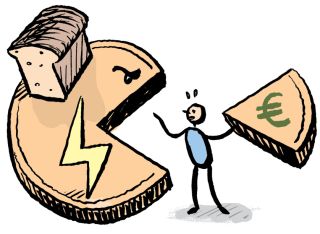
Several energy companies have announced increases in the past few months, adding to the cost of living crisis. This will, of course, impact almost every household in the country. But some more than others.
Arrears
According to the latest EU SILC (Survey on Income and Living Conditions), 7 per cent of the population, some 350,000 people, were living in households with utility arrears in 2021. The survey on which this data is based was conducted in the first part of the year, prior to the inflation increases which began in earnest from October. When broken down by disposable income percentile (quintiles), we can see that 8.7 per cent of people in the lowest 20 per cent of the income distribution were in arrears on utilities twice or more in the previous year, while a further 3 per cent were in arrears once. Almost one in eight people in the bottom 20 per cent of income earners had been in arrears on a utility bill in 2021. This compares to just 2 per cent of those in the top 20 per cent. (Table 1).
Table 1: Arrears on Utilities by Household Disposable Income Percentile, 2021
| Household Disposable Income Percentile | Yes, once | Yes, twice or more | Total |
| Less than 20 | 3.0 | 8.7 | 11.7 |
| 20-39 | 2.5 | 6.5 | 9.0 |
| 40-59 | 1.6 | 5.9 | 7.5 |
| 60-79 | 0.9 | 4.0 | 4.9 |
| 80-100 | 0.2 | 1.8 | 2.0 |
Source: CSO, Survey on Income and Living Conditions 2021, PxStat SIA111
It should therefore come as no surprise that people experiencing poverty and deprivation are more likely to have been in arrears on utilities than those who were not in 2021. Of the 580,000 people experiencing poverty in 2021, 16 per cent had been in arrears at some point in the previous year, with 13.1 per cent being in arrears twice or more. Of the 691,000 people in enforced deprivation in 2021, one third were in arrears, with more than one in four being in arrears twice or more in the previous year. This compares to 5.5 per cent of people not in poverty and less than 3 per cent of those not experiencing deprivation. (Table 2)
Table 2: Arrears on Utilities by Poverty Status, 2021
| Poverty Status | Yes, once | Yes, twice or more | Total |
| Not at risk of poverty | 1.4 | 4.1 | 5.5 |
| Not experiencing deprivation | 1.0 | 1.8 | 2.8 |
| At risk of poverty | 2.9 | 13.1 | 16.0 |
| Experiencing deprivation | 5.6 | 27.4 | 33.0 |
| In consistent poverty | 3.6 | 35.0 | 38.6 |
Source: CSO, Survey on Income and Living Conditions 2021, PxStat SIA112
Lone parents were the household type most likely to have been in arrears on utilities in 2021, with one in four having fallen behind in the previous year and 16.5 per cent being in arrears twice or more. This is followed by 8.7 per cent of two adult households aged under 65, and Other households with children. (Table 3).
Table 3: Arrears on Utilities by Household Composition, 2021
| Household Composition | Yes, once | Yes, twice or more | Total |
| All household compositions | 1.6 | 5.4 | 7.0 |
| 1 adult aged 65 years and over | 1.5 | 2.1 | 3.6 |
| 1 adult aged less than 65 years | 1.9 | 6.0 | 7.9 |
| 2 adults, at least 1 aged 65 years and over | 0.7 | 0.9 | 1.6 |
| 2 adults, both aged less than 65 years | 1.5 | 7.2 | 8.7 |
| 3 or more adults | 0.5 | 4.4 | 4.9 |
| 1 adult, with children under 18 years | 8.5 | 16.5 | 25.0 |
| 2 adults, with 1-3 children under 18 years | 1.6 | 5.8 | 7.4 |
| Other households with children under 18 years | 1.0 | 7.1 | 8.1 |
Source: CSO, Survey on Income and Living Conditions 2021, PxStat SIA109
Finally on this point, it will come as no surprise to many that households in rented accommodation are more likely to have had arrears on utility bills in 2021 than owner occupiers. Renters (private sector and social housing tenants) were twice as likely to have experienced arrears than the general population and more than five times more likely than owner occupiers. (Table 4).
Table 4: Arrears on Utilities by Tenure Status, 2021
| Tenure Status | Yes, once | Yes, twice or more | Total |
| Owner-occupied | 0.8 | 2.3 | 3.1 |
| Rented or rent free | 3.5 | 12.2 | 15.7 |
Source: CSO, Survey on Income and Living Conditions 2021, PxStat SIA109
Going without Heat / Unable to keep the home warm
The SILC survey also collects data on 11 deprivation indicators to establish the rate of enforced deprivation. Two of these indicators are relevant here: households who were "without heating at some stage in the last year" and those who were "unable to afford to keep the home adequately warm". Table 5 sets out the prevalence of each of these indicators by poverty status. Overall, 7.1 per cent of the population went without heating at some stage in the previous year to 2021, while 3.2 per cent said they were unable to keep the home adequate warm. Some 17.1 per cent of those experiencing poverty and 36.6 per cent of those experiencing deprivation went without heating.
Table 5: Deprivation Indicator by Poverty Status, 2021
| Poverty Status | Without heating at some stage in the last year | Unable to afford to keep the home adequately warm |
| Percentage of individuals | 7.1 | 3.2 |
| Percentage of individuals NOT at risk of poverty | 5.7 | 2.5 |
| Percentage of individuals NOT experiencing deprivation | 2.3 | 0.3 |
| Percentage of individuals at risk of poverty | 17.1 | 8.7 |
| Percentage of individuals experiencing deprivation | 36.6 | 21.2 |
| Percentage of individuals in consistent poverty | 43.3 | 24.2 |
Source: CSO, Survey on Income and Living Conditions 2021, PxStat SIA80
It is difficult to compare Table 5 to the previous Tables. Not every household in arrears will go without heat, depending on the actions taken by the supplier. Also, not every household receives a utility bill. Some, particularly low-income, households use pre-pay or "pay as you go" meters which rely on the household buying credit or tokens to top up the meter before they can have access to electricity or gas. Notwithstanding the fact that these meters are most often used by low-income households or households in rented accommodation, they tend to be more expensive than paying utility bills by direct debit as credit / tokens can be subject to a surcharge.
While there may be some overlap between these datasets, the extent of that overlap cannot be estimated without further interrogation of the datasets.
Energy Prices
According to Eurostat, Ireland has the fourth highest electricity price for household consumers in the EU27 (it is the highest before taxes and levies). Ireland has consistently had higher than average consumer electricity prices compared to the EU27, however since the second half of 2018 the gap has widened significantly (Charts 1 and 2).
Chart 1: Electricity Prices for Household Consumers, EU 27, S2 2021
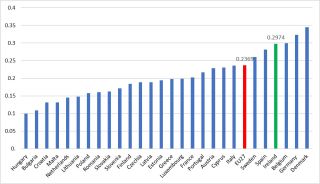
Source: Eurostat Database [NRG_PC_204]
Chart 2: Electricity Prices for Household Consumers, Ireland and EU27 Average, S2 2021
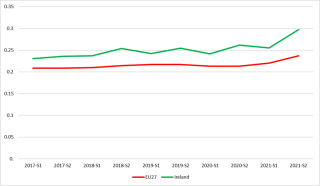
Source: Eurostat Database [NRG_PC_204]
In terms of gas prices for household consumers (including taxes and levies), Ireland is eighth of the EU27 countries for which data is available, and is closer to the EU27 average than electricity prices (Chart 3).
Chart 3: Gas prices for household consumers, EU 27, S2 2022
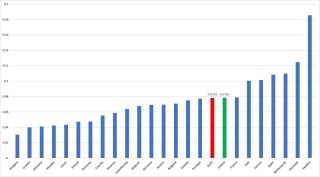
Source: Eurostat Database [NRG_PC_202]
Consumer gas prices in Ireland have tracked closely to the EU27 average over the past number of years. The gap widened in S2 of 2018 and S2 of 2019, however since S2 2020, there has been virtually no difference (Chart 4).
Chart 4: Gas Prices for Household Consumers, Ireland and EU27, 2017 to 2021
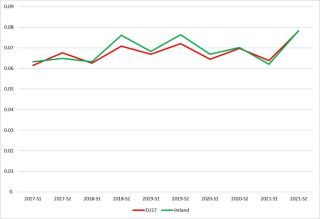
Source: Eurostat Database [NRG_PC_202]
Energy Costs and Cost of Living
The latest CSO Consumer Price Index publication showed that the cost of living increased by 9.1 per cent to July 2022. When energy costs are excluded, the increase was 5.9 per cent. The COICOP division for "Housing, Water, Electricity, Gas and Other Fuels" had the highest rate of increase in the year to July 2022 at 21.6 per cent. A breakdown of the components of this division indicates that electricity, gas and other fuels increased by 54.8 per cent, with electricity prices increasing by 40 per cent and gas by 56.6 per cent. Home heating oil had the highest rate of increase at 91.9 per cent (Table 6).
Table 6: COICOP Division 04 Housing, Water, Electricity, Gas and Other Fuels, July 2022
| Description | % Change | ||
| Actual rentals for housing & mortgage interest | 10.1 | ||
| Actual rentals for housing paid by tenants (Rents) | 12.1 | ||
| Private rents | 12.9 | ||
| Local Authority rents | 7.9 | ||
| Mortgage Interest | 4.4 | ||
| Maintenance and Repair of the Dwelling | 5.8 | ||
| Materials for the maintenance and repair of the dwelling | 9.9 | ||
| Services for the maintenance and repair of the dwelling | 3.2 | ||
| Water supply & miscellaneous services relating to the dwelling | 3.6 | ||
| Electricity, gas & Other Fuels | 54.8 | ||
| Electricity | 40.0 | ||
| Gas | 56.6 | ||
| Natural Gas | 60.2 | ||
| Bottled Gas | 9.7 | ||
| Liquid fuels (Home Heating Oil) | 91.9 | ||
| Solid Fuels | 31.8 | ||
| Total | 21.6 | ||
Source: CSO, 2022: Consumer Price Index July 2022, www.cso.ie
Support Required
While the impact of the cost of living is being felt by almost every household across the country, it is not impacting all equally. Data produced by the CSO showed that households in the lowest 20 per cent of the income distribution experienced the highest rate of increase in the year to June 2022, at over 10 per cent, while those in the top income deciles experiencing lower rates of increase at approximate 8 per cent (Table 7).
Table 7: Percentage Change over 12 months for Consumer Price Index, June 2022
| Income Decile | % |
| 1st decile | 10.0 |
| 2nd decile | 10.3 |
| 3rd decile | 9.9 |
| 4th decile | 9.8 |
| 5th decile | 9.5 |
| 6th decile | 9.3 |
| 7th decile | 8.9 |
| 8th decile | 8.5 |
| 9th decile | 8.5 |
| 10th decile | 8.2 |
| All Deciles | 9.1 |
Source: CSO, 2022: Consumer Price Index June 2022, www.cso.ie
The effect of inflation is hitting the living standards of those on the lowest incomes the most. Government decisions regarding measures to address the rising cost of living must be focused on improving the situation of people living on inadequate incomes. These households spend a larger proportion of their income on food and energy. They are low-income individuals and families who have no additional disposable income, people who are already struggling to make ends meet. The cost of living crisis is an income adequacy crisis. These are the households who are most exposed to price increases. Government policy and resources must be targeted at these low-income households to assist with the growing living cost challenges they face.
Government’s initiatives to tackle the cost of living crisis earlier this year were welcome, but deeply inadequate and not sufficiently targeted to those in greatest need. This must be addressed in Budget 2023.
Social Justice Ireland has consistently argued that core social welfare rates should be benchmarked to 27.5 per cent of average weekly earnings, to prevent those on the lowest incomes being left behind. As the cost of living continues to rise in 2022 the real value of social payments has been eroded by the failure to benchmark core social welfare rates. Compared to 2011, the real value of Jobseekers Benefit in 2022 is just over €192 per week, and the real value of the Contributory State Pension in 2022 is just over €234 per week. The ever-increasing cost of energy is eroding the value of these payments further.
In 2021, the gap between core social welfare rates and 27.5 per cent of average weekly earnings was €19 per week. Today, the gap is €27 per week. This is the increase required to core social welfare rates and pensions in the next Budget if current trends are maintained. Otherwise, the value of social welfare payments will fall and the gap between the most vulnerable and the rest of society will continue to widen.
Government must bridge this €27 per week gap, starting with an increase in Budget 2023 of €20 per week, and any further packages aimed at mitigating rising costs for people must be targeted at those who need it most, those on the lowest incomes. Blanket solutions, such as the VAT reduction on gas and electricity, and those announced earlier in February and March are not going to protect the poorest and most vulnerable.
However, if energy prices continue to rise, any increases to fixed incomes (such as social welfare payments) will be eroded. Government must step in to invoke extraordinary measures such as capping tariffs for consumers and SMEs (small and medium enterprises); apply a windfall gains tax to the excess profits of energy companies profiteering from a cost of living crisis; and expand the definition of "vulnerable consumer" to include financial vulnerability to ensure that households on the lowest incomes will avoid disconnection.